Sites of Japan's Meiji Industrial Revolution: Iron and Steel, Shipbuilding and Coal Mining
Sites of Japan's Meiji Industrial Revolution: Iron and Steel, Shipbuilding and Coal Mining (明治日本の産業革命遺産 製鉄・鉄鋼、造船、石炭産業, Meiji nihon no sangyōkakumei isan: seitetsu, tekkō, zōsen, sekitan sangyō) are a group of historic sites that played an important part in the industrialization of Japan in the Bakumatsu and Meiji periods (1850s - 1910), and are part of the industrial heritage of Japan.[1] In 2009 the monuments were submitted jointly for inscription on the UNESCO World Heritage List under criteria ii, iii, and iv. The sites were accepted at the 39th UNESCO World Heritage session.
| UNESCO World Heritage Site | |
|---|---|
 Aerial photograph of Hagi Castle Town | |
| Location | Japan |
| Criteria | Cultural: (ii), (iv) |
| Reference | 1484 |
| Inscription | 2015 (39th session) |
| Area | 306.66 ha (757.8 acres) |
| Buffer zone | 2,408.33 ha (5,951.1 acres) |
| Coordinates | 34°25′50″N 131°24′44″E |
.svg.png.webp) Location of Sites of Japan's Meiji Industrial Revolution: Iron and Steel, Shipbuilding and Coal Mining in Earth | |
Eight areas are registered, with twenty-three component sites:
Area 1: Hagi in Yamaguchi
Hagi proto-industrial sites and Tokugawa period cultural setting; Hagi, Yamaguchi Prefecture:
| Site | Comments | Image |
|---|---|---|
| Hagi reverberatory furnace (萩反射炉, Hagi hansharo) (ID1484-001)[2][3] | Historic Site |  |
| Ebisugahana shipyard (恵美須ヶ鼻造船所跡, Ebisugahana zōsensho ato) (ID1484-002)[4] | Historic Site |  |
| Ōitayama-tatara iron smelting works (大板山たたら製鉄遺跡, Ōitayama tatara seitetsui ato) (ID1484-003)[4][5] | Prefectural Historic Site |  |
| Hagi castle town (萩城下町, Hagi jōkamachi) (ID1484-004)[6][7] | Historic Site; Groups of Traditional Buildings |  |
| Shōkasonjuku Academy (松下村塾, Shōkason juku) (ID1484-005)[8][9] | run by Yoshida Shōin; Historic Site |  |
Area 2: Kagoshima
Shūseikan pioneering factory complex; Kagoshima, Kagoshima Prefecture:
| Site | Comments | Image | |
|---|---|---|---|
| Former Shūseikan (旧集成館, kyū Shūseikan) (ID1484-006)[10][11] | Historic Site | ||
| Remains of Shūseikan Reverbatory Furnaces (旧集成館反射炉跡, Shūseikan hansyaro ato) | Historic site | 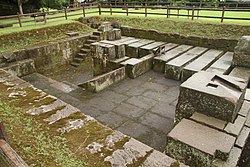 | |
| Shūseikan machine factory (旧集成館機械工場, Shūseikan kikai kōjō)[10][12] | erected in 1865; Important Cultural Property |  | |
| Former Kagoshima spinning engineer's residence (旧鹿児島紡績所技師館, kyū Kagoshima hōsekijo gishi-kan)[13][14] | erected in 1867; Important Cultural Property |  | |
| Terayama Charcoal Kiln (寺山炭窯跡, Terayama sumigama ato) (ID1484-007) |
constructed in 1858, Historic site | ||
| Sekiyoshi Sluice gate of Yoshino leat (関吉の疎水溝, Yoshino no sosuikō) (ID1484-008) |
constructed in 1852 | ||
Area 3: Nirayama in Shizuoka
Nirayama proto-industrial reverberatory furnace; Izunokuni, Shizuoka Prefecture:
| Site | Comments | Image |
|---|---|---|
| Nirayama Reverberatory Furnace (韮山反射炉, Niirayama hansharo) (ID1484-009)[15] |
started construction in 1853, completed in 1855, Historic Site |  |
Area 4: Kamaishi in Iwate
Hashino iron mining and smelting site; Kamaishi, Iwate Prefecture:
| Site | Comments | Image |
|---|---|---|
| Hashino iron mining and smelting site (橋野鉄鉱山, Hashino tekkōzan) (ID1484-010)[16] | influenced Yawata (see below); Historic Site | 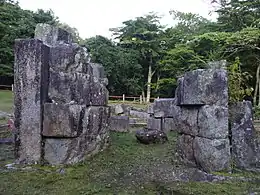 |
Area 5: Saga
Mietsu shipyard; Saga, Saga Prefecture:
| Site | Comments | Image |
|---|---|---|
| Mietsu Naval Dock (三重津海軍所跡, Mietsu kaigunsho ato) (ID1484-011) [17] | constructed in 1858, Historic Site |  |
Area 6: Nagasaki
Nagasaki shipyard facilities, coal mining islands and associated sites; Nagasaki, Nagasaki Prefecture:
| Site | Comments | Image |
|---|---|---|
| Kosuge Slip Dock (小菅修船場跡, Kosuge shūsenba ato) (ID1484-012)[18][19] | completed in 1868, Historic Site |  |
| Mitsubishi No.3 Dry Dock (三菱長崎造船所 第三船渠, Mitsubishi Nagasaki Zōsenjyo Daisan Senkyo) (ID1484-013) |
completed in 1905 | |
| Mitsubishi Senshokaku Guest House (長崎造船所 占勝閣, Nagasaki Zōsenjyo Senshōkaku) (ID1484-014) |
completed in 1904 | |
| Mitsubishi Giant Cantilever Crane (長崎造船所 ジャイアント・カンチレバークレーン, Nagasaki Zōsenjyo Giant Cantilever Crane) (ID1484-015)[20] | set up in 1909[21] | 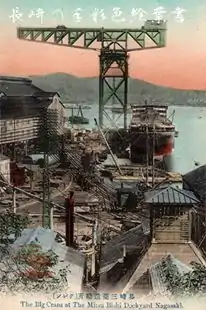 |
| Mitsubishi Former Pattern Shop (長崎造船所 旧木型場, Nagasaki Zōsenjyo Kyuu Kigataba) (ID1484-016) |
completed in 1898 | |
| Takashima Coal Mine (高島炭鉱, Takashima Coal Mine) (ID1484-017)[22][23] | started excavation in 1868, Municipal and Historic Site | |
| Hashima coal mine (端島炭坑, Hashima tankō) (ID1484-018)[23][24] | started excavation in 1870, Historic Site | 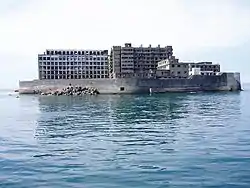 |
| Glover House and Office (旧グラバー住宅, kyū Gulabā jūtaku) (ID1484-019)[25][26] | erected in 1863; Important Cultural Property | 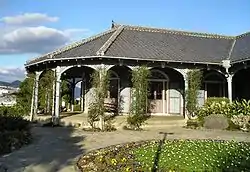 |
Area 7: Miike in Fukuoka and Kumamoto
Miike coal mines, railway and ports; Ōmuta, Fukuoka Prefecture, Arao and Uki, Kumamoto Prefecture:
| Site | Comments | Image | |
|---|---|---|---|
| Miike Coal Mine and Miike Port (三池炭鉱、三池港, Miike tankō, Miike-kō) (ID1484-020) |
|||
| Miike tankō Miyanohara Pit (三池炭鉱 宮原坑, Miike tankō Miyahara kou)[27][28] | no.1 pit completed in 1898, no.2 pit completed in 1901, Important Cultural Property | 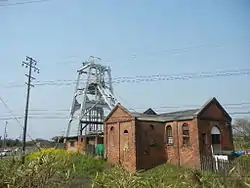 | |
| Miike tankō Manda Pit (三池炭鉱 万田坑, Miike tankō Manda kou) | no.1 pit completed in 1902, no.2 pit completed in 1908, Important Cultural Property |  | |
| Miike tankō coal mine industrial railway (三池炭鉱 専用鉄道敷跡, Miikekō ・Miike tankō senyō tetsudō ato)[29] | opened in 1891, extended to Miike Port in 1905, Important Cultural Property |  | |
| Miike Port (三池港, Miike-kō) | opened in 1887, Important Cultural Property, Important cultural landscape |  | |
| Misumi West Port (三角西港, Misumi nishi-kō) (ID1484-021)[30][31] | constructed in 1887, Important Cultural Property |  | |
Area 8: Yahata in Fukuoka
Yawata steel works; Kitakyūshū and Nakama, Fukuoka Prefecture:
| Site | Comments | Image | |
|---|---|---|---|
| The Imperial Steel Works, Japan (旧官営八幡製鐵所関連施設, kyū kanei Yahata seitetsusho kanren shisetsu) (ID1484-022)[32] |
establishing political decision was made in 1897, started operation in 1901, "Heritage of Industrial Modernization" by METI. | 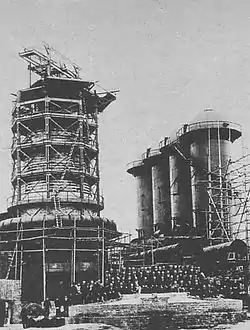 | |
| The Imperial Steel Works: Office (八幡製鐵所 旧本事務所, Yahata seitetsusho kyū-jimusyo) | constructed in 1899 |  | |
| The Imperial Steel Works: Repairing factory (八幡製鐵所 修繕工場, Yahata seitetsusho syūzen-kōjou) | constructed in 1900, the oldest steel structure in Japan, still under operation. | ||
| The Imperial Steel Works: Metalsmith factory (八幡製鐵所 旧鍛冶工場, Yahata seitetsusho kyū-kaji-kōjou) | constructed in 1900 | ||
| Onga river Pumping Station (遠賀川水源地ポンプ室, Onga-gawa suigenchi ponpu-shitsu) (ID1484-023)[20] |
constructed in 1910, still under operation. |  | |
Controversy
The inclusion of some of these properties as UNESCO Heritage sites arraised concerns and objections from South Korea, on the grounds that conscripted Korean civilians and Chinese prisoners-of-war were forced to work under harsh conditions at seven of these sites during Japan's World War II mobilization policies. There is a research questioning about Japanese government's compliance with UNESCO regulations and requirements with respect to Hashima Coal Mine site.[33]
Although the period at which forced labour took place does not coincide with the period of Meiji industrial revolution, the criticism arose based on the view that the Meiji industrial revolution was 'inseparable from 20th-century empire-building, which led inexorably to Japanese colonialism and the Asia-Pacific War'.[34] South Korea claimed that the official recognition of those sites would "violate the dignity of the survivors of forced labor as well as the spirit and principles of the UNESCO Convention", and "World Heritage sites should be of outstanding universal value and be acceptable by all peoples across the globe."[34] China also released a similar statement that “World Heritage application should live up to the principle and spirit of promoting peace as upheld by UNESCO.”[34]
See also
- World Heritage Sites in Japan
- Hidden Christian Sites in the Nagasaki Region
References
- "Sites of Japan's Meiji Industrial Revolution: Iron and Steel, Shipbuilding and Coal Mining". UNESCO. Retrieved 5 July 2015.
- "Hagi Reverberatory Furnace". Kyuyama. Archived from the original on 16 October 2013. Retrieved 17 February 2012.
- "萩反射炉". Agency for Cultural Affairs. Archived from the original on 10 December 2019. Retrieved 17 February 2012.
- "Ebisugahana shipyard & Ohitayama-Tatara iron smelting works". Kyuyama. Archived from the original on 16 October 2013. Retrieved 17 February 2012.
- "大板山たたら製鉄遺跡". Yamaguchi Prefecture. Archived from the original on 10 September 2012. Retrieved 17 February 2012.
- "Hagi Castle Town". Kyuyama. Archived from the original on 16 October 2013. Retrieved 17 February 2012.
- "萩城城下町". Agency for Cultural Affairs. Archived from the original on 10 December 2019. Retrieved 17 February 2012.
- "The Shokasonjuku Academy". Kyuyama. Archived from the original on 16 October 2013. Retrieved 17 February 2012.
- "松下村塾". Agency for Cultural Affairs. Archived from the original on 10 December 2019. Retrieved 17 February 2012.
- "Former Shūseikan and machine factory". Kyuyama. Archived from the original on 16 October 2013. Retrieved 17 February 2012.
- "旧集成館". Agency for Cultural Affairs. Archived from the original on 5 December 2019. Retrieved 17 February 2012.
- "旧集成館機械工場". Agency for Cultural Affairs. Archived from the original on 5 December 2019. Retrieved 17 February 2012.
- "Former Kagoshima Spinning Engineer's Residence". Kyuyama. Archived from the original on 16 October 2013. Retrieved 17 February 2012.
- "旧鹿児島紡績所技師館". Agency for Cultural Affairs. Archived from the original on 23 December 2019. Retrieved 17 February 2012.
- "Sites of Japan's Meiji Industrial Revolution: Iron and Steel, Shipbuilding and Coal Mining". UNESCO. Retrieved 21 October 2015.
- "橋野鉄鉱山の歴史" [The history of Hashino iron mining and smelting site]. Iwate Prefecture. Retrieved June 2, 2020.
- "Mietsu Naval Dock". Saga Prefecture. Retrieved June 2, 2020.
- "Site of Kosuge ship repair dock". Kyuyama. Retrieved 17 February 2012.
- "小菅修船場跡". Agency for Cultural Affairs. Archived from the original on 10 December 2019. Retrieved 17 February 2012.
- "Emergence of Industrial Japan: Kyushu - Yamaguchi" (PDF). Kyuyama. Retrieved 17 February 2012.
- "三菱重工業長崎造船所ハンマーヘッド型起重機". Agency for Cultural Affairs. Archived from the original on 23 December 2019. Retrieved 17 February 2012.
- "Hokkei well shaft, Takashima coal mine". Kyuyama. Archived from the original on 25 January 2015. Retrieved 17 February 2012.
- "北渓井坑跡". Nagasaki City. Archived from the original on 19 December 2012. Retrieved 17 February 2012.
- "Hashima coal mine". Kyuyama. Archived from the original on 16 October 2013. Retrieved 17 February 2012.
- "Former Glover House". Kyuyama. Archived from the original on 16 October 2013. Retrieved 17 February 2012.
- "旧グラバー住宅(長崎県長崎市南山手町)". Agency for Cultural Affairs. Archived from the original on 23 December 2019. Retrieved 17 February 2012.
- "Miyanohara Pit, Miike coal mine". Kyuyama. Archived from the original on 16 October 2013. Retrieved 17 February 2012.
- "三井石炭鉱業株式会社三池炭鉱宮原坑施設". Agency for Cultural Affairs. Archived from the original on 23 December 2019. Retrieved 17 February 2012.
- "Miike Port and Coal Mine Industrial Railway". Kyuyama. Archived from the original on 16 October 2013. Retrieved 17 February 2012.
- "Misumi West Port". Kyuyama. Archived from the original on 16 October 2013. Retrieved 17 February 2012.
- "三角旧港(三角西港)施設". Agency for Cultural Affairs. Archived from the original on 23 December 2019. Retrieved 17 February 2012.
- "The State-owned Yawata Steel Works". Kyuyama. Archived from the original on 16 October 2013. Retrieved 17 February 2012.
- Palmer, David (January 1, 2018). "Gunkanjima / Battleship Island, Nagasaki: World Heritage Historical Site or Urban Ruins Tourist Attraction?". The Asia-Pacific Journal: Japan Focus. 16 (1). Retrieved July 4, 2020.
- "Story of Japan's industrial rise deserves to be told, forced labor and all". The Japan Times. 2015-06-24. Retrieved 2020-07-05.